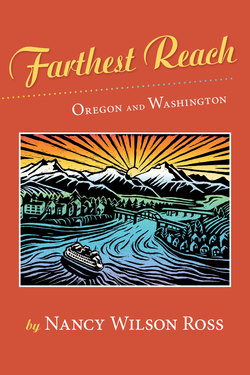Читать книгу Farthest Reach - Nancy Wilson Ross - Страница 9
На сайте Литреса книга снята с продажи.
ОглавлениеCHAPTER III
The Seasons
The months from April to October in the Pacific Northwest give so rich a variety of experience in scent, form, and color that even the native is often bemused with the weather and nature’s generosity.
Spring in the Pacific Northwest might be said to begin officially when people set out on rhododendron viewing expeditions along the miles of the Olympic Peninsula or the Oregon coast. The rhododendron is the state flower of Washington. Oregon chose a more useful plant, the Oregon grape, which bears yellow bells of blossom in spring and purple globes of berry in autumn, besides offering a year-round spot of glistening green in the dankest landscape. Like the Japanese, however, who worship the pink cherry which yields no fruit—since this teaches, they say, “the subtle use of the useless”—the Northwesterner worships the rhododendron which graciously lends its rosy beauty to ugly wastes of logged-off land as well as to untouched forest fringes.
About the time that rhododendrons appear, Scotch broom also comes along to herald the season, and meadows and canyons assail the eye with glitter of brilliant yellow. Pussywillow doesn’t count as a messenger of a new season in the Northwest, for it is apt to appear at Christmas if the season is mild, and be gathered for a New Year green along with the dark red berries of the kinnikinik or Indian tobacco.
Timed to coincide with rhododendron and Scotch broom, the groves turn white with dogwood and wild cherry, and erratic winds carry the spice of blossoming red currant. Downy plumes of spiraea signal the passing airs; fields display purple and white iris and the sky-blue cornflower. Then west coast forests hide the three-petaled trillium, pale bleeding hearts with lacy leaves, the gentle, secretive brown ginger, and the small precious orchid known as Lady Slipper. Fragrant pink twin-vine riots delicately over logs and mossy earth. Fungus of a thousand varieties, in every tone from white to deepest purple, re-create in the damp woods curiously marine memories, the frills and convolutions of conchs, or coral, or even sea anemones.
When the flat-petaled pink rose opens along every country road, spotted foxgloves are defining the marshy lines of languid streams; and in the seasonal swamp lands, vibrant with frog-song, the beautiful and dignified skunk cabbage defies its lowly name. The air along the coast carries the mingled scent of salt spray, sun-warmed conifers, and the first fruit blooms. Inland it’s the scent of sage, pungent with the spring showers, and sprays of flowering thorn. The winds are languorous with wild syringa, the mock orange of which Lewis and Clark took note in their Journal, and from whose straight shoots Indians sometimes made arrows. Up the river valleys travels the breath of mountain balm or cinnamon bush, azalea, pine sap, and last year’s needles which carpet the stirring earth. Prairies mark the sun’s climb with carpets of purple violet and yellow buttercup, blue lupine, camas, and leopard lily. Mountain meadows display the curious markings of mission bells and arrogant tufts of Indian paintbrush. Shooting stars point the wind with their black-tipped pink arrows.
With early summer, hill slopes yield the tiny wild strawberry of unsurpassed flavor, and then the trout are leaping in the swollen streams. Later the salmon berries ripen in every cool ravine, and so one knows the salmon are running. When summer deepens it brings the wild blackberry, growing on logged-off land, where fireweed also raises its slender magenta wand. Soon follow the great bush blackberries; head high sprawls of burdened branches, yielding lavish harvest to any passerby with a tin pail.
As the earth begins to cool, huckleberry, elderberry, and blueberry darken on bushes in the mountains and along the prairie trails. This is the season when, not long ago, all the Indian women went out to gather camas root for the winter’s food supply. They still pick berries, the Indians, and on the roads near White Salmon one may see them picking up one side and the whites up the other. Vine maple sends thrusts of brilliant red and yellow up the rocky slopes of mountain passes and along the boiling rivers. Then the restless madrona—forever peeling its green and brown bark—yields its orange berries to greedy birds, south-bound. Wild geese cry in the night, traveling high above the fog. Ducks rise whirring from freshwater lake and salty cove. Gulls are long since back from the north to cry mournfully on the shore.
After the dry summer, with forest fire warnings posted on every roadside, the good smell of burning brush rises into the air. The mountains take on fresh coats of snow. Against the first gray skies they stand out with startling clarity; they seem to move nearer with a new and formidable intimacy, an almost menacing beauty.
On the coast the rains begin. People withdraw to their fireplaces. The run on the local libraries sets in. It is winter. In eastern valleys alchemy of fog and frost creates enchanted landscapes; bare trees in thrall to crystal, shrubs of spun glass and weeds of spun sugar along the hill slopes where the brief sun has no power. The gray light plays a range of cool and icy blues over these frosted forms, and in the distance they seem to exhale a white breath.
Over the weekends, east and west, hundreds of cars, ski-laden, make the brief trips that take their owners out of tideland and valley rain or frosty fog and bring them to clear mountain air, to ski and toboggan runs and miles of powder snow.
The skiers are still practicing christianias and slaloms on the snowy slopes when the alpine meadows set forth their annual pointillists’ display of riotous color along the melting snow line. . . . The Season has turned again.
